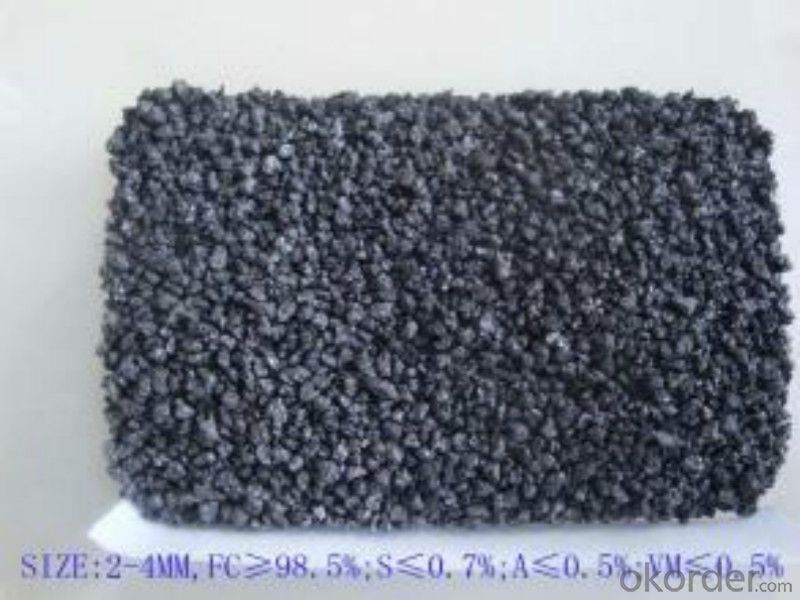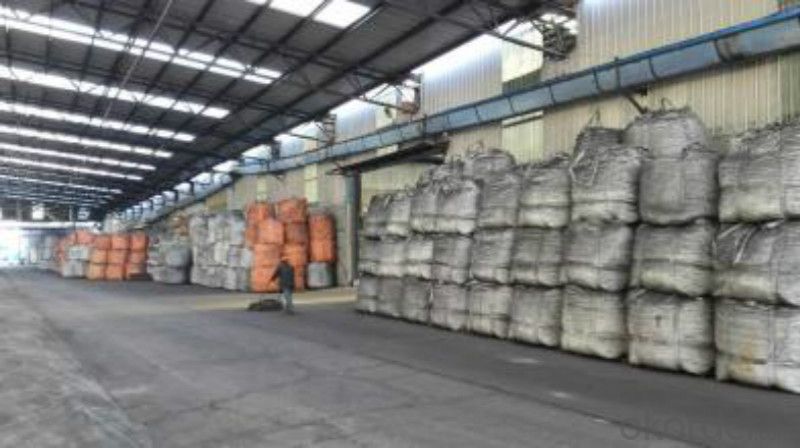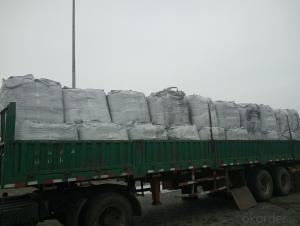Calcined Pitch Coke with Ash 0.5 percent max used in EAF
- Loading Port:
- Tianjin
- Payment Terms:
- TT OR LC
- Min Order Qty:
- 21 m.t.
- Supply Capability:
- 8000 m.t./month
OKorder Service Pledge
OKorder Financial Service
You Might Also Like
Introduction
Pitch Coke/Coal Tar Pitch is a kind of black brittleness and blocky piece, lustrously at normal temperature. It has special odour and poisonous and can be easily flame when melting, second-grade inflammable solid.
Pitch Coke/Coal Tar Pitch is obtained from powerfully processed coal tar. Compared to petroleum asphalt, the adhesiveness is better. Coal Tar Pitch is high quality tar production with high fixed carbon. It has excellent adhesion, waterproofing and resistance against seawater, oil and various chemicals. In these properties, it is much better than petroleum asphalt tar.
It can be used to produce painting, electrode, pitch coke, and tar felt. It also can be used as fuel and the raw material of asphalt carbon black.
Features:
The morphology, chemistry and crystallinity of recarburisers have a major impact on the overall casting cost. The combined application and cost benefits, which are derived through the use of Desulco, enable foundries to manufacture castings in a highly cost effective manner.
reduces
Recarburiser consumption
Power consumption
Inoculant consumption
MgFeSi consumption
Furnace refractory wear
Scrap rate
Tap to tap time
Slag inclusions risk
Chill
increases
Casting microstructure
Productivity
Process consistency
Carbon Recovery
Compared with calcined petroleum coke, acetylene coke and
graphite electrode scrap, Desulco yields the highest carbon
recovery and fastest dissolution time
Specifications:
CPC | |||
F.C.% | 98.5MIN | 98.5MIN | 98MIN |
ASH % | 0.8MAX | 0.8MAX | 1MAX |
V.M.% | 0.7 MAX | 0.7 MAX | 1 MAX |
SULFUR % | 0. 5MAX | 0. 7MAX | 1MAX |
MOISTURE % | 0.5MAX | 0.5MAX | 1MAX |
Pictures:




FAQ:
1.MOQ:2 Containers |
2.Size:1-3mm,1-5mm,2-6mm,3-5mm and as the customer's requirement |
3.Packing: 1 ton jumbo bag or 25kgs paper in bag |
4.Payment:T/T or L/C at sight |
5.Delivery time: within 15 days after receiving the deposit |
6.Usage: it is as carbon raiser,widely used in steelmaking,casting,casting iron,steel foundry,aluminum metallury. |
- Q:What's the difference between an alkaline cell and a carbon cell?
- Alkaline batteries, also known as alkaline dry cells, alkaline manganese dioxide batteries and alkaline manganese batteries, are among the best in the range of zinc manganese batteries. The utility model is suitable for large discharge capacity and long time use. The internal resistance of the battery is low, so the current produced is larger than that of the general manganese battery, while the environmental friendly mercury content is only 0.025%. A carbon cell belongs to a primary battery in a chemical power supply and is a disposable battery. Because the chemical power unit has an electrolyte that is a non flowing paste, it is also called a dry cell, as opposed to a battery with a flowing electrolyte. Carbon battery is not only suitable for the flashlight, radios, tape recorders, cameras, semiconductor, electronic clocks, toys and other fields, but also for national defense, scientific research, telecommunication, navigation, aviation, medicine, etc. in the national economy.
- Q:What is the role of carbon in organic chemistry?
- Carbon is the backbone of organic chemistry as it has the unique ability to form covalent bonds with other carbon atoms and a wide variety of other elements, resulting in the vast diversity of organic compounds. It is the element that allows for the formation of complex molecules, such as carbohydrates, proteins, lipids, and nucleic acids, which are essential for life processes.
- Q:How does carbon impact the fertility of soil?
- Soil fertility relies heavily on carbon, which serves as the foundation for organic matter. Organic matter, derived from decaying plant and animal residues, enhances the soil's structure, nutrient-holding capacity, and water retention. This results in improved support for plant growth and microbial activity. Not only does organic matter supply carbon, but it also provides nutrients to plants through the process of decomposition. Microorganisms, fungi, and bacteria decompose organic matter and release nutrients like nitrogen, phosphorus, and potassium into the soil. These nutrients become available for plants to absorb. Additionally, carbon in organic matter binds soil particles, preventing erosion and improving soil structure. Furthermore, carbon plays a crucial role in water management for plants. It acts as a sponge, absorbing and retaining moisture, which helps sustain plant growth during dry periods. Carbon also fosters the growth of a diverse and healthy microbial community in the soil, including beneficial bacteria and fungi. These microorganisms contribute to nutrient cycling, disease suppression, and plant nutrient uptake, further enhancing soil fertility. However, it is important to avoid excessive carbon inputs or improper land management practices, as they can negatively affect soil fertility. An imbalance in carbon availability can lead to nitrogen immobilization, where microorganisms consume nitrogen for their own growth, depriving plants of this essential nutrient. Additionally, high carbon content can create anaerobic conditions, limiting oxygen availability for plant roots and beneficial soil organisms. To ensure optimal soil fertility, it is crucial to maintain a balanced carbon-to-nitrogen ratio and adopt sustainable land management practices. Carbon is an indispensable component for maintaining soil health by improving structure, nutrient availability, water retention, and microbial activity.
- Q:What are the advantages of carbon-based batteries?
- There are several advantages of carbon-based batteries that make them a popular choice in various applications. Firstly, carbon-based batteries, such as alkaline batteries, have a longer shelf life compared to other types of batteries. This means that they can retain their charge for extended periods of time, making them ideal for devices that are used infrequently or in emergency situations. Secondly, carbon-based batteries offer a higher energy density, meaning that they can store more energy in a smaller package. This makes them more compact and lightweight, which is advantageous for portable electronic devices like smartphones, laptops, and cameras. Furthermore, carbon-based batteries typically have a lower self-discharge rate, meaning they lose less charge over time when not in use. This allows them to maintain their power for longer periods without requiring frequent recharging or replacement. Carbon-based batteries also tend to have a higher discharge rate, meaning they can deliver power more quickly when needed. This is beneficial for devices that require a sudden burst of energy or for high-drain applications like digital cameras or power tools. Moreover, carbon-based batteries are generally more cost-effective compared to other types of batteries. They are widely available, inexpensive to produce, and can be easily recycled, reducing environmental impact. In conclusion, the advantages of carbon-based batteries include a longer shelf life, higher energy density, lower self-discharge rate, higher discharge rate, cost-effectiveness, and environmental friendliness. These features make them a reliable and efficient choice for a wide range of electronic devices and applications.
- Q:How is carbon dioxide formed?
- Carbon dioxide is formed through various natural and human activities. It is naturally produced by the respiration of animals, the decay of organic matter, and volcanic eruptions. Additionally, human activities such as the burning of fossil fuels, deforestation, and industrial processes also contribute to the formation of carbon dioxide.
- Q:What are the effects of carbon emissions on agriculture?
- Carbon emissions have numerous detrimental effects on agriculture. Firstly, increased levels of carbon dioxide (CO2) in the atmosphere contribute to global warming, leading to changes in rainfall patterns and more frequent extreme weather events such as droughts, floods, and heatwaves. These weather conditions disrupt agricultural production by reducing crop yields, damaging crops, and increasing the prevalence of pests and diseases. Higher temperatures also accelerate the rate of evaporation, resulting in soil moisture deficits and water scarcity, which negatively impact crop growth and productivity. In addition, elevated CO2 levels can alter the nutritional content of crops, reducing their quality and nutritional value. For example, studies have shown that increased CO2 concentrations can decrease the protein content in wheat and rice, leading to potential health issues for those who rely on these staple crops. Furthermore, carbon emissions contribute to the formation of ground-level ozone, a harmful air pollutant. Ozone damages plant cells, inhibits photosynthesis, and reduces crop yields. It particularly affects sensitive crops such as soybeans, wheat, and cotton. The effects of carbon emissions on agriculture are not limited to crop production. Livestock farming is also impacted as rising temperatures and water scarcity make it more challenging to maintain adequate grazing lands and provide sufficient water and fodder for animals. Additionally, changes in climate patterns can lead to the spread of livestock diseases and pests, further endangering the livestock industry. Overall, carbon emissions have a cascading effect on agriculture, leading to reduced crop yields, lower nutritional value, livestock farming challenges, and increased vulnerability to pests, diseases, and extreme weather events. Addressing and mitigating carbon emissions is crucial to safeguarding global food security and ensuring the sustainability of agricultural systems.
- Q:How is carbon formed in stars?
- Carbon is formed in stars through a process called stellar nucleosynthesis, specifically in the later stages of a star's life. This occurs when helium nuclei (alpha particles) fuse together under high temperatures and pressures to form carbon nuclei.
- Q:What can light hydrocarbon carbon five be packed with?
- Gas used as a common gas:The light hydrocarbon gas generation device (light hydrocarbon gas generating unit) consists of six basic systems and three safety systems. Includes six basic systems: the host system, fuel supply system, heat system, control system, air system, closed unloading material system. The three major safety systems include ventilation system, lightning protection system, and electrostatic heating system for light hydrocarbon gas.In operation, the working pressure in the gasifier and the static pressure and dynamic pressure of the transmission pipe network are in theBetween 0.01 and 0.02MPa, the normal operating temperature of the gasifier is no more than 45 degrees centigrade, which is lower than that stipulated by the national pressure vessel.
- Q:What are the consequences of increased carbon emissions on economic stability?
- Increased carbon emissions have significant consequences on economic stability. One of the most notable impacts is the exacerbation of climate change, leading to more frequent and severe natural disasters such as hurricanes, floods, and wildfires. These events result in immense economic damage, including the destruction of infrastructure, loss of property, and disruption of supply chains. Furthermore, the effects of climate change, driven by increased carbon emissions, also have long-term economic implications. Rising sea levels threaten coastal cities and industries, leading to the potential displacement of populations and loss of valuable assets. Extreme heatwaves and droughts can damage agricultural productivity, affecting food security and increasing prices. These climate-related disruptions can destabilize economies, particularly in vulnerable regions heavily reliant on agriculture or tourism. Additionally, efforts to mitigate and adapt to climate change, such as transitioning to cleaner energy sources and implementing climate policies, require significant financial investments. This can strain government budgets and divert resources away from other socio-economic priorities, potentially leading to reduced funding for education, healthcare, and infrastructure development. Moreover, the economic consequences of increased carbon emissions extend beyond immediate climate-related impacts. The reliance on fossil fuels as the primary source of energy contributes to volatile oil prices, which can disrupt global markets and impact economic stability. As the world moves towards a low-carbon economy, industries heavily dependent on fossil fuels may face significant challenges, leading to job losses and economic dislocation. In summary, increased carbon emissions have far-reaching consequences on economic stability. The resulting climate change leads to more frequent and severe natural disasters, causing substantial economic damage. Furthermore, the need to respond to climate change through mitigation and adaptation efforts can strain government budgets and divert resources away from other essential sectors. Lastly, the reliance on fossil fuels contributes to volatile oil prices and poses long-term risks to industries tied to these resources. Addressing carbon emissions is crucial for safeguarding economic stability and promoting sustainable growth.
- Q:When is gold resistance better? When will carbon resistance be better?
- The gold resistance is of high accuracy, but the price is high. The resistance value of the carbon resistor is low, but it is cheap!
1. Manufacturer Overview |
|
|---|---|
| Location | |
| Year Established | |
| Annual Output Value | |
| Main Markets | |
| Company Certifications | |
2. Manufacturer Certificates |
|
|---|---|
| a) Certification Name | |
| Range | |
| Reference | |
| Validity Period | |
3. Manufacturer Capability |
|
|---|---|
| a)Trade Capacity | |
| Nearest Port | |
| Export Percentage | |
| No.of Employees in Trade Department | |
| Language Spoken: | |
| b)Factory Information | |
| Factory Size: | |
| No. of Production Lines | |
| Contract Manufacturing | |
| Product Price Range | |
Send your message to us
Calcined Pitch Coke with Ash 0.5 percent max used in EAF
- Loading Port:
- Tianjin
- Payment Terms:
- TT OR LC
- Min Order Qty:
- 21 m.t.
- Supply Capability:
- 8000 m.t./month
OKorder Service Pledge
OKorder Financial Service
Similar products
New products
Hot products




























